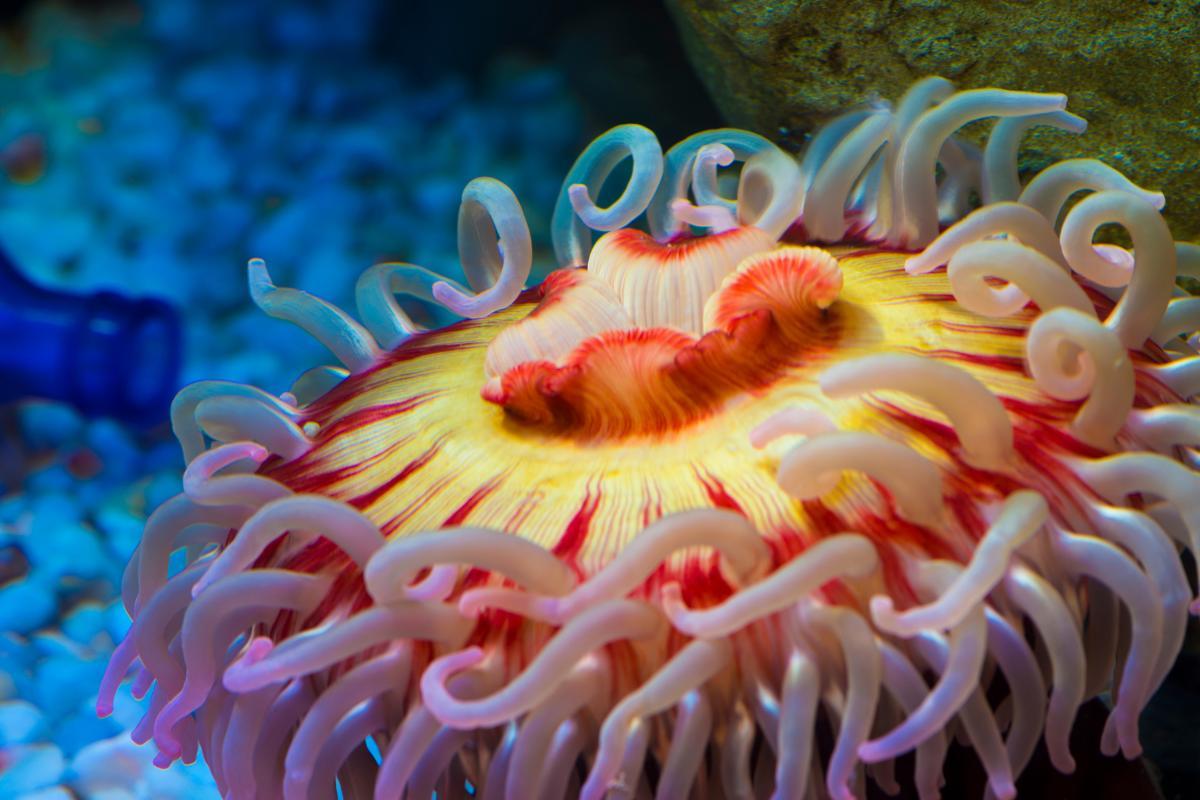What Are Sea Anemones? Types, Characteristics & Facts


From tropical coral reefs to frigid polar waters, sea anemones have adapted to thrive in almost every ocean environment. While they might look like colorful underwater flowers gently swaying in the current, they are actually skilled predators belonging to the phylum Cnidaria. Their unique combination of plant-like appearance and predatory abilities makes them one of the ocean's most intriguing inhabitants.
In the following AnimalWised article, we will explore what sea anemones are, their different types, their characteristics, and other surprising facts about these marine animals.
What are sea anemones?
Sea anemones belong to phylum Cnidaria, along with jellyfish, and share class Anthozoa with corals. While their fixed position and flower-like tentacles make them look like plants, they are actually predatory animals that move, catch and eat small sea creatures. Their success is evident in their worldwide distribution, from tropical coral reefs to the coldest polar waters.
Unlike true plants, sea anemones have complex bodies designed for catching and eating prey. Their distinctive appearance comes from a crown of tentacles surrounding a central mouth, which they use to capture and consume small marine creatures. These tentacles contain specialized stinging cells, a characteristic feature of all cnidarians, which they use both for hunting and defense.
While they typically stay anchored to one spot using their adhesive foot, sea anemones can actually move when necessary. They can detach from their chosen location and either crawl to a new spot or let the currents carry them. This mobility, combined with their predatory nature and complex body structure, clearly distinguishes them from the plants they superficially resemble.
Did you know that sea anemones belong to an ancient group of animals that has existed for over 500 million years? Explore the world of Cnidarians in our detailed article

Characteristics of sea anemones
These sea creatures have developed extraordinary skills and tools that enable them to flourish in the ocean. But, what is it that makes them so special? Let's take a look at their main characteristics:
- Their body follows a simple, but effective design with a hollow central cylinder surrounded by tentacles. The body is mostly gelatinous, composed of water, which gives them flexibility to adapt to ocean currents and changing conditions in their environment.
- Despite their plant-like appearance, sea anemones are skilled predators. Their tentacles contain specialized cells called cnidocytes that release toxins to immobilize prey. These tentacles surround a central mouth where they pull in captured fish, crustaceans, and other small marine creatures for digestion.
- While they appear stationary, sea anemones can actually move. They typically anchor themselves to rocks, shells, or coral reefs using their basal disk, but they can detach and drift to new locations when threatened, especially to escape predatory starfish.
- One of their most remarkable features is their ability to regenerate damaged parts. If they lose tentacles or suffer body damage, they can regrow these parts, making them incredibly resilient to injuries and attacks.
- Though seemingly simple, sea anemones possess a basic but effective nervous system. This network of neurons allows them to detect and respond to environmental changes, potential prey, and threats in their surroundings.
- Their stinging tentacles serve a dual purpose as both hunting tools and defense against predators. The nematocysts can deliver a painful sting to deter potential threats, making them well-protected against many marine creatures.
- Sea anemones are masters of cooperation in the marine world. The most famous example is their partnership with clownfish, which find protection among their tentacles thanks to a special mucus coating. The anemone benefits from this relationship by receiving food scraps and protection from predators.
- Their flexible body structure allows them to thrive in various ocean environments, from warm shallow waters to cold deep seas. They can adjust their size and shape in response to environmental conditions, helping them survive in different habitats.
Intrigued by how different species work together for mutual benefit? Explore more amazing examples of nature's partnerships in our other article.

Types of sea anemones
Sea anemones are part of the order Actiniaria, which is currently divided into 3 suborders. Within these suborders, scientists have identified approximately 46 families containing around 1,200 described species worldwide.
Suborder Nyantheae
As the largest and most diverse group, Nyantheae contains approximately 42 families and 1,100 species.
These anemones have a strong foot for attachment, a body that can stretch and shrink, and tentacles arranged in circles around their mouth. They're the masters of adaptation, found everywhere from tide pools to deep oceans.
You might recognize some members of this group: the bright-colored anemones in tide pools (family Actiniidae), the carpet anemones that host clownfish (family Stichodactylidae), and the large, cold-water anemones of the deep sea (family Actinostolidae).
What makes them special is their ability to pull their tentacles inside their body for protection, like pulling a turtle's head into its shell.
Suborder Endocoelantheae
This much smaller group contains 2 families and around 40 species.
They have a simpler internal structure than their Nyantheae cousins and are often found buried in soft sand or mud rather than attached to rocks.
Suborder Protantheae
Representing the most primitive and smallest group, Protantheae contains 2 families and approximately 20 species. They're usually small, often nearly transparent, and lack many features found in other anemones. They don't have a strong foot for attachment, and their body structure is much simpler. Studying these anemones helps scientists understand how sea anemones first evolved.
It is important to note that with new molecular techniques, we're constantly learning more about how sea anemones are related, and sometimes this changes how we used to classify them based just on their looks. New species are still being discovered, especially in the deep sea, so the classification system is always being updated.

Is it safe to touch sea anemones?
While sea anemones may look harmless with their soft, flowing tentacles, it's important to understand that they do sting. Remember, it's how they catch their food and defend themselves. Their tentacles contain special cells called cnidocytes that can release toxins through tiny structures known as nematocysts.
For most humans, touching a sea anemone isn't particularly dangerous. The sting usually feels like a mild burning sensation and might cause slight redness on your skin, similar to a minor jellyfish sting. However, keep in mind that some people may have stronger reactions, much like how some people are more sensitive to bee stings than others.
Safety tips:
- If you're unsure about the species, avoid touching.
- People with sensitive skin or allergies should be especially cautious.
- If stung, rinse the area with seawater (not fresh water).
- Seek medical attention if you develop an unusual reaction.
Want to learn more about marine animals with stinging abilities? Discover which floating relatives of sea anemones are surprisingly harmless in our other article.

Where do sea anemones live?
From the warm, crystal-clear waters of tropical reefs to the dark depths of the ocean, sea anemones have found ways to thrive in almost every marine environment. They can be found throughout the world's oceans, each species suited to its particular habitat.
Most commonly, you'll find sea anemones in shallow coastal waters where sunlight is plentiful. They firmly attach themselves to rocks, coral reefs, and other hard surfaces, creating stable homes in areas where ocean currents might otherwise sweep them away.
While most species prefer shallow waters, certain sea anemones have adapted to extreme depths, existing at up to 6,000 meters below the surface. Some species have evolved to inhabit soft substrates, partially embedding themselves in sandy or muddy seafloors instead of attaching to hard surfaces.
The richest diversity of sea anemones occurs in tropical and subtropical oceans, where warm waters and abundant sunlight create ideal conditions for many species. However, these hardy animals have also adapted to life in extreme environments. In fact, you'll find specialized species thriving in the frigid waters of both the Arctic and Antarctic, demonstrating their remarkable ability to adapt to challenging conditions.

What do sea anemones eat?
Most sea anemones are opportunistic carnivores, capturing any suitable prey that comes within reach of their tentacles.
Using their specialized stinging cells, they paralyze small fish, crustaceans, and other marine invertebrates that swim or drift too close. Once immobilized, the prey is pulled into the anemone's central mouth by the tentacles.
Some species have developed more specialized feeding strategies. Certain deep-sea anemones can capture much larger prey than their shallow-water cousins, while others have adapted to feed on plankton and organic particles suspended in the water. These different feeding strategies reflect their adaptation to various marine environments and available food sources.
Additionally, many sea anemones benefit from symbiotic relationships that supplement their diet. Some species host microscopic algae within their tissues, gaining extra nutrients from the algae's photosynthesis. Also, as mentioned earlier, the partnership between clownfish and anemones also provides the anemone with food. The fish's waste products supply nutrients, and their activity helps circulate water, bringing more prey within reach of the anemone's tentacles.

How do sea anemones reproduce?
Sea anemones can reproduce in two ways, sexually and asexually. This flexibility is just another example of how well they've adapted to survive and thrive in different environments.
During sexual reproduction, males and females release their eggs and sperm into the water where fertilization happens. The fertilized eggs grow into tiny, free-swimming larvae (called planulae) that float in the ocean currents. When these larvae find a good spot to live, they attach themselves to a surface and grow into adult anemones.
Sea anemones can also multiply without needing a partner through asexual reproduction.
Most commonly, they do this by splitting their body into two parts (called fission), with each part growing into a complete new anemone. Some species can also produce small copies of themselves through a process called budding, where small anemones grow from the parent's body and eventually break off to live independently.
Having two ways to reproduce gives sea anemones important advantages. Sexual reproduction mixes genes from different parents, helping create stronger and more adaptable offspring. Asexual reproduction lets successful anemones quickly multiply in favorable locations, passing on their beneficial traits to the next generation.
Want to learn about other creatures that can split in two like sea anemones? Dive into our fascinating guide about animals that can multiply on their own.
If you want to read similar articles to What Are Sea Anemones? Types, Characteristics & Facts, we recommend you visit our Facts about the animal kingdom category.
- Beress, L., & Beress, R. (2019). Sea anemone toxins: A structural overview. Marine Drugs, 17(7), 380. https://doi.org/10.3390/md17070380
- Stefanik, D. J., Friedman, L. E., Finnerty, J. R., & Baxevanis, A. D. (2019). Evolution of regeneration in sea anemones. Frontiers in Ecology and Evolution, 7, 24. https://doi.org/10.3389/fevo.2019.00024
- Schlesinger, A., Zlotkin, E., & Kramarsky-Winter, E. (2009). The ecological importance of toxicity: Sea anemones maintain functional complex venom under abiotic stress. Toxins, 11(5), 266. https://doi.org/10.3390/toxins11050266
- Bocharova, E. S., & Kozevich, I. A. (2011). Modes of reproduction in sea anemones (Cnidaria, Anthozoa). Biology Bulletin, 38, 849–860.
- Shick, J. M. (Ed.). (2012). A functional biology of sea anemones. Springer Science & Business Media.
- Scott, A. (2017). Be anemones. In Marine Ornamental Species Aquaculture (pp. 437–456).
- Van-Praet, M. (1985). Nutrition of sea anemones. In Advances in Marine Biology (Vol. 22, pp. 65–99). Academic Press.











